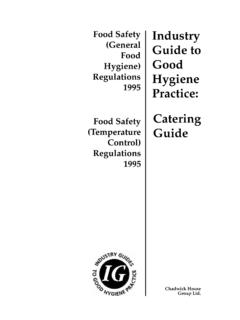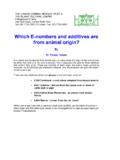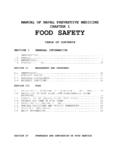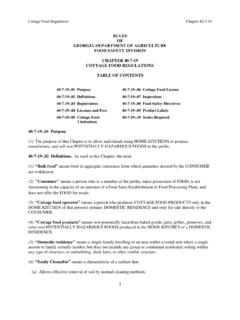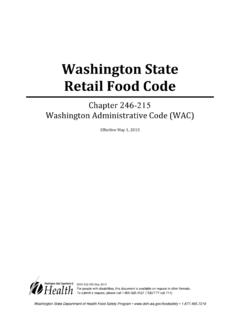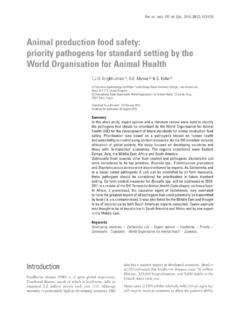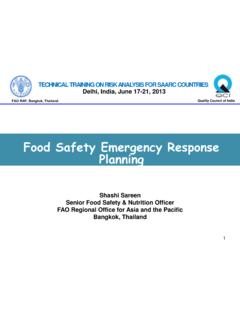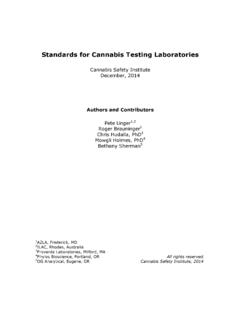Transcription of Food Safety Industry Guide to Hygiene) Good …
1 food Safety (GeneralFoodHygiene)Regulations199 5 food Safety (TemperatureControl)Regulations199 5 IndustryGuide toGoodHygienePractice:BakingGuideCha d wi c k Ho us eGr o up Lt d . food Safety (GeneralFoodHygiene)Regulations199 5 food Safety (TemperatureControl)Regulations199 5 IndustryGuide toGoodHygienePractice:BakingGuideChadwic k HouseGroup Court15 HatfieldsLondon SE1 8 DJTel: 0171 827 5882 Main switchboard: 0171 827 9929 Fax:0171 827 9930 Chadwick House Group Ltd. (CHGL) is a commercial company, wholly owned by theChartered Institute of Environmental Health (CIEH). The company's mission is toprovide quality products and services to create awareness and to raise standards in thehealth environment and Safety of the public. We intend to remain the premierprovider by continual investment in our people, products and services in support ofthe aims of the CIEH. Our main activities are focused on training, communicationsand conferences and exhibitions. It also markets a wide selection of books and videosrelating to environmental health.
2 The CIEH is a professional and educational body,founded in 1883 and dedicated to the promotion of environmental health and toencouraging the highest possible standards in the training and the work ofenvironmental health officers. The Chartered Institute has over 9,000 members most ofwhom work for local authorities in England, Wales and Northern Ireland. Apart fromproviding services and information to members, the Institute also advises governmentdepartments on environmental health and is consulted by them on any proposedlegislation relevant to the work of environmental health Chartered Institute is a Registered Charity. food Safety and hygiene Working Group for The Baking GuideApplications for reproduction should be made to Chadwick House Group impression 1997 ISBN0 900 103 55 8iiiThis Industry Guide to good hygiene practice gives advice tobakery businesses on how to comply with the food Safety (General food hygiene ) Regulations 1995 and thecorresponding regulations in Northern is an official Guide to the Regulations which has beendeveloped in accordance with Article 5 of the EC Directive onthe hygiene of Foodstuffs (93/43/EEC).
3 The Guide also contains advice on how to comply with theFood Safety (Temperature Control) Regulations this Guide is not legally binding, food Authoritiesmust give it due consideration when enforcing is hoped that the information which this Guide containswill help bakers both to meet their legal obligations and toensure food 1 PrefaceChapter 0 Chapter HeadingivThanks are due to the following organisations and their representatives whoformed the working party responsible for the development of this Guide :National Association of Master BakersJanet Carr (Chairman of the working party) - Warings Master Bakers LtdChris Dabner (Secretary to the working party) - hygiene & Safety OfficerBiscuit, Cake, Chocolate and Confectionery AllianceNigel Shipman - Lyons Cakes LtdFederation of BakersTony Casdagli - DirectorKate Hodgetts - Three Cooks LtdScottish Association of Master BakersIan Hay - Chief ExecutiveDavid Clark - Aulds (Foods) LtdLACOTSMark Du ValClare CunninghamDavid LockDepartment of HealthWilliam ConnonPeter MartinThe working party are grateful to all those members of theirAssociations/Organisations who read and commented on the drafts duringits development.
4 They would also like to thank all those individuals,organisations including Consumer Groups and local authorityenvironmental health departments and liaison groups for their commentssubmitted during the public consultation exercise. These were very usefuland much the working party would like to express their thanks to GillianSmith of the NAMB for her keyboard 1 AcknowledgementsChapter 0 Chapter HeadingFOR INFORMATION:If you need help to understand the guidance in this booklet contact your local environmentalhealth department.(Urdu)(Gujarati)(Chinese)(Ben gali)(Punjabi)(Greek)(Turkish)ContentsPa gePart 1 Introduction1 General Introduction1 Scope of the Guide2 Part 2 Hazard Analysis (Regulation 4(3))3 The legal requirement to identify hazards, measures to control them and those steps in the process which are critical to food SafetyPart 3 Schedule One of the Regulations -The 'Rules of hygiene '23 Adetailed Guide to the requirementsChapter IGeneral Requirements for food Premises24 Chapter IISpecific Requirements for Rooms where Foodstuffs are prepared, treated or31processedChapter IIIR equirements for Moveable and/or Temporary Premises (such as marquees, 36market stalls, mobile sales vehicles) premises used primarily as private dwelling houses, premises used occasionally for catering purposes and vending machines(No guidance has been given as this Chapter is not applicable to the bakingindustry).
5 Chapter IVTransport of Food37 Chapter VEquipment Requirements40 Chapter VIHandling and Disposal of food Waste43 Chapter VIIW ater Supply45 Chapter VIIIP ersonal hygiene Requirements for anyone working in 47or entering a food businessChapter IXRequirements for the Handling of Foodstuffs50 Chapter XTraining -54 The requirement for the supervision and instruction and/or training of food handlersPart 4 Temperature Control64 Adetailed Guide to the requirements of the food Safety (Temperature Control) Regulations 1995for Englandand Walesand the separate requirements for Scotland. Including details of theexemptions for egg custards and meat pies, cornish pasties and sausage rolls and the scientificassessment for an upward variation in temperature control for cream 5 Appendices -These do not form part of the Recognised Guidance. They contain background78information and various forms and record sheets which can be used, if cleaning checklist79 TwoExample of a pictorial cleaning schedule80 ThreeCleaning schedule81 FourInformation on wall surfaces83 FiveInformation on flooring materials85 SixTemperature check record87 SevenExtract from Workplace (Health, Safety and Welfare) Regulations 1992 on sanitary conveniences and washing stations88 EightGood hygiene practice table90 NinePre-employment questionnaire91 TenDelivery check record92 ElevenExample of a pest control form94 TwelveExample of a pest control summary sheet95 ThirteenPest control services96 FourteenList of organisations providing formal training courses97 FifteenTraining record98 SixteenPersonal training record99 SeventeenStaff training record100 Part 6 Glossary, References, Useful Addresses101 Glossary:Definitions of Various Terms used in this GuideReferences.
6 Details of Other Regulations and Documents mentioned in this GuideContacts:Useful Contact AddressesThe purpose of this Guide is to provide bakers with guidance on how to comply withthe requirements of the food Safety (General food hygiene ) Regulations 1995 and theFood Safety (Temperature Control) Regulations 1995, and with the corresponding Regulations in Northern particular, the Guide will:-lgive clear guidance on what is required to comply with the requirements of the Regulations;lin relation to the baking Industry to clarify and explain the terms "wherenecessary" and "where appropriate" where these appear in the Regulations;lto provide more specific guidance on practices specific to the baking Industry to ensure the Safety of the food produced;lto give clear advice relating to various aspects of good manufacturing Guide was produced by a Working Party consisting of members/representativesfrom the National Association of Master Bakers, the Scottish Association of MasterBakers, the Federation of Bakers and the Biscuit, Cake, Chocolate and ConfectioneryAlliance, with assistance from representatives from the Department of Health andLACOTS (see Acknowledgements page for further details).
7 The Guide has been developed in accordance with Article 5 of the Directive 93/43/EECon the hygiene of Foodstuffs and the Department of Health s guidance booklet - ATemplate Advice on the Compilation of UK Industry Guides to good hygiene has undergone the required three month period of public Guide has the status implied by regulation 8(2)(c) of the food Safety (General FoodHygiene) Regulations 1995, regulation 19(2)(c) of the food Safety (Temperature Control)Regulations 1995 and the corresponding Regulations in Northern Ireland. EnforcementOfficers must give "due consideration" to what the Guide says when assessing whetherbakers are complying with the requirements of these this Guide sets out a recommended way by which bakers can comply with theGeneral food hygiene and Temperature Control Regulations, there is no legalrequirement for bakers to follow the advice. Bakers may be able to find alternativeways of complying with the Regulations. In that event, it is up to the proprietor ofthe business to demonstrate to the enforcement authority that he/she has compliedwith the requirements of the Guide only deals with the food Safety (General food hygiene ) Regulations 1995and the food Safety (Temperature Control) Regulations 1995 and their Northern Irelandequivalents.
8 There are other Acts ( food Safety Act 1990) and Regulations which can ordo govern the production and sale of food by bakers. Some may impinge on generalissues of food hygiene . For example, there are various Health and Safety regulationsdealing with the provision of toilets, wash hand basins, accommodation for outdoorclothing, the Safety and use of cleaning materials etc; date marking of food is governedby the food Labelling Regulations 1996; the disposal of waste (Schedule 1, Chapter VI)is regulated by the Environmental Protection Act 1990. In a few instances specific crossreferences to other pieces of legislation have been made for the sake of clarity. In general it was deemed impractical to include cross references to all the other 1 INTRODUCTION1:Introduction1 However, whilst not dealt with in this Guide , the bakery business must be aware of allthe other legislation governing its operation, take account of the various legal requirements and take action where necessary to ensure that their business complieswith all the legal duties imposed on Practice: The Guide also provides advice and information on good are clearly differentiated from the guidance on compliance and for Schedule 1 Chapters I to IX they appear in a separate column on the right hand side of the pageheaded "Advice on good Practice".
9 It is NOT a legal requirement to follow the adviceon good practice. It is entirely up to individual businesses whether they wish to heedand implement the advice given, and it has no legal standing with regard to enforcement of and compliance with the Regulations. The sections on good practice arenot and Records: There is NO explicit requirement in the General FoodHygiene or Temperature Control Regulations for bakers to document policies, procedures and systems or to keep records. In a number of instances, the keeping ofwritten records, eg for hygiene training may assist in demonstrating compliance withthe Regulations. In the event of enforcement action under these Regulations, documented procedures and records of routine checks may be of use in the establishment of a "due diligence" defence as described in the food Safety Act sectors of the Baking Industry covered by this Guide are :-lRetail Craft BakerieslWholesale Craft BakeriesThese can vary in size from a small unit behind a shop to a very large bakery supplying a large number of either their own branch shops or wholesale outlets, including catering establishments, with a wide range of bakery goods including bread,rolls, cakes, other flour confectionery and savouries, the majority of which areunwrapped.
10 Occasionally, the bakery business may be more highly specialised producing a much more limited range which may be BakeriesThe guidance on compliance given in the Retail Industry Guide is consistent with that given in this Guide . Therefore, whilst either Guide could be used, it is recommended for simplicity that the Retail Industry Guide is used. In the circumstances, instore bakeries should be considered outside the formal scope of this Guide for the purposes of the requirements in the legislation that the Guide be given due consideration by enforcement ShopsBakery shops should also be considered outside the formal scope of this Guide for the purposes of the requirements in the legislation that the Guide be given due consideration by enforcement Guide does NOT cover:- Plant BakeriesPlant bakeries are usually large highly automated units producing a limited range ofbread products (mainly sliced and wrapped loaves) or biscuits or cakes for wholesale,the majority of which are packaged and have a well known brand name.
